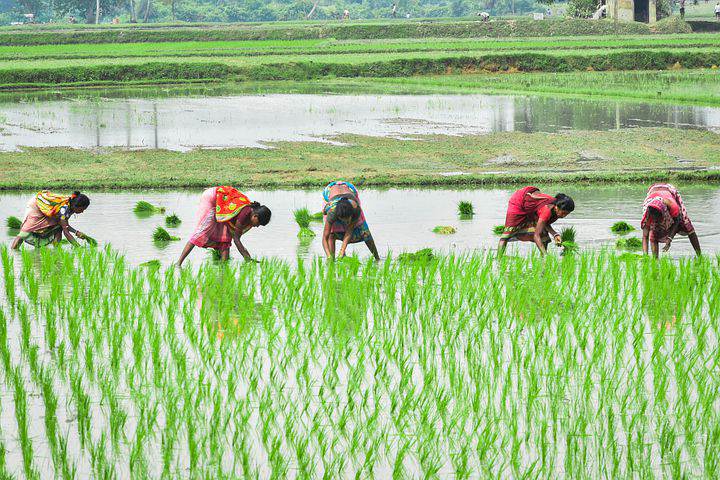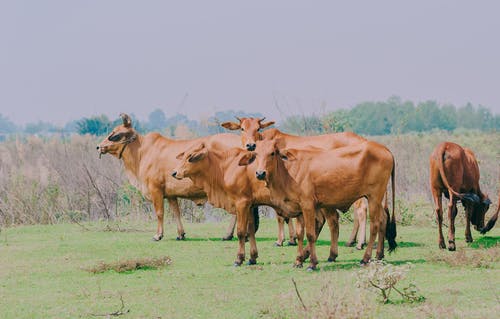
राज्यवार भारतीय फसलें | Indian crops state wise
भारत गेहूँ, चावल, मक्का, जौं, बाजरा, कपास, मूंगफली, नारियल, तिलहन, दलहन, चाय इत्यादि फसलें उगाने वाला देश है। भारत में फसलों का वितरण निम्नानुसार है।
भारत की फसलें और उनके उत्पादक राज्य निम्नलिखित हैं -
1. गेहूँ - उत्तर प्रदेश, मध्य प्रदेश, पंजाब
2. चावल - उत्तर प्रदेश, पश्चिम बंगाल, पंजाब
3. मक्का - कर्नाटक, महाराष्ट्र, मध्यप्रदेश
4. गन्ना - कर्नाटक, उत्तर प्रदेश, महाराष्ट्र
5. बाजरा - उत्तर प्रदेश, गुजरात, राजस्थान
6. ज्वार - कर्नाटक, महाराष्ट्र, मध्यप्रदेश
7. कुल तिलहन - राजस्थान, महाराष्ट्र, मध्य प्रदेश
8. कुल दालें - महाराष्ट्र, राजस्थान, मध्य प्रदेश
9. चाय - असम, पश्चिम बंगाल, केरल, तमिलनाडु
10. कॉफी - केरल, कर्नाटक, तमिलनाडु
11. नारियल - तमिलनाडु, केरल, कर्नाटक, आंध्र प्रदेश
12. कपास - तेलंगाना, गुजरात, महाराष्ट्र
13. रबड़ - कर्नाटक, केरल, त्रिपुरा
14. सब्जी उत्पादन - पश्चिम बंगाल, बिहार, उत्तर प्रदेश, मध्य प्रदेश
15. फल उत्पादन - आंध्र प्रदेश, गुजरात, महाराष्ट्र, उत्तर प्रदेश
16. अरहर - कर्नाटक, महाराष्ट्र, मध्य प्रदेश
17. सोयाबीन - राजस्थान, मध्य प्रदेश, महाराष्ट्र
18. मूंगफली - गुजरात, राजस्थान, आंध्र प्रदेश
19. चना - महाराष्ट्र, राजस्थान, मध्य प्रदेश
20. सूरजमुखी - कर्नाटक, उड़ीसा, बिहार
21. रेपसीड और सरसों - मध्य प्रदेश, राजस्थान, हरियाणा
22. जूट और मेस्ता - बिहार, पश्चिम बंगाल, असम
23. कुल खाद्यान्न - मध्य प्रदेश, उत्तर प्रदेश, पंजाब में उगाये जाते हैं।
Following are the crops of India and their producing states -
1. Wheat - Uttar Pradesh, Madhya Pradesh, Punjab
2. Rice - Uttar Pradesh, West Bengal, Punjab
3. Mecca - Karnataka, Maharashtra, Madhya Pradesh
4. Sugarcane - Karnataka, Uttar Pradesh, Maharashtra
5. Millet - Uttar Pradesh, Gujarat, Rajasthan
6. Jowar - Karnataka, Maharashtra, Madhya Pradesh
7. Total oilseeds - Rajasthan, Maharashtra, Madhya Pradesh
8. Total pulses - Maharashtra, Rajasthan, Madhya Pradesh
9. Tea - Assam, West Bengal, Kerala, Tamil Nadu
10. Coffee - Kerala, Karnataka, Tamil Nadu
11. Coconut - Tamil Nadu, Kerala, Karnataka, Andhra Pradesh
12. Cotton - Telangana, Gujarat, Maharashtra
13. Rubber - Karnataka, Kerala, Tripura
14. Vegetable Production - West Bengal, Bihar, Uttar Pradesh, Madhya Pradesh
15. Fruit Production - Andhra Pradesh, Gujarat, Maharashtra, Uttar Pradesh
16. Arhar - Karnataka, Maharashtra, Madhya Pradesh
17. Soybeans - Rajasthan, Madhya Pradesh, Maharashtra
18. Groundnut - Gujarat, Rajasthan, Andhra Pradesh
19. Gram - Maharashtra, Rajasthan, Madhya Pradesh
20. Sunflower - Karnataka, Orissa, Bihar
21. Rapeseed and Mustard - Madhya Pradesh, Rajasthan, Haryana
22. Jute and Mesta - Bihar, West Bengal, Assam
23. Total food grains - are grown in Madhya Pradesh, Uttar Pradesh, Punjab.
Rice - It is mainly kharif or tropical crop. It can be grown in three seasons due to its climate adaptability in Tamil Nadu and West Bengal. Three crops of rice are grown in West Bengal -
1. Dew - It is a autumn crop.
2. Aman - It is a winter crop.
3. Boro - It is a summer crop.
Cultivation of rice requires smooth fertile soil, average temperature (about 25 °) and annual rainfall of 100 cm. Rice is cultivated in the largest area of the total cultivable land in India. The major rice producing states are West Bengal, Bihar, Orissa, Assam, Chhattisgarh, Jharkhand, Andhra Pradesh, Tamil Nadu etc. The western and eastern coastal areas, the Brahmaputra plain, the major delta region, the Giripad hills of the Himalayas, the Terai region, etc. are included in the major geographical regions of rice production in India. The major varieties of rice are Karuna, Jamuna, Padma, Jaya, Krishna, Kanchi, Hansa, Kaveri, Mahi-Sugandha, Pusa-Sugandha 5, Ratna and Bala etc.
चावल - यह मुख्य रूप से खरीफ अथवा उष्णकटिबंधीय फसल है। यह तमिलनाडु और पश्चिम बंगाल में जलवायु अनुकूलता होने की वजह से तीन ऋतुओं में उगाया जा सकता है। पश्चिम बंगाल में चावल की तीन फसलें उगाई जाती हैं -
1. ओस - यह शरद कालीन फसल है।
2. अमन - यह शीतकालीन फसल है।
3. बोरो - यह ग्रीष्मकालीन फसल है।
चावल की खेती करने हेतु चिकनी उपजाऊ मृदा, औसत तापमान (लगभग 25°) और वार्षिक वर्षा 100 सेंटीमीटर की जरूरत होती है। भारत की कुल कृषि करने योग्य भूमि में सबसे अधिक क्षेत्रफल में चावल की खेती की जाती है। चावल के प्रमुख उत्पादक राज्य पश्चिम बंगाल, बिहार, उड़ीसा, असम, छत्तीसगढ़, झारखंड, आंध्र प्रदेश, तमिलनाडु आदि हैं। पश्चिमी एवं पूर्वी तटीय क्षेत्र, ब्रह्मपुत्र का मैदान, प्रमुख डेल्टाई क्षेत्र, हिमालय की गिरिपद पहाड़ियाँ, तराई प्रदेश आदि को भारत में चावल उत्पादन के प्रमुख भौगोलिक क्षेत्रों में शामिल किया जाता है। चावल की प्रमुख किस्में करुणा, जमुना, पद्मा, जया, कृष्णा, काँची, हंसा, कावेरी, माही-सुगंधा, पूसा-सुगंध 5, रत्ना तथा बाला आदि हैं।
Maize - It is a kharif crop. It is included under C4 plants . This crop requires 21 ℃ to 27 ℃ temperature and 50 to 70 cm annual rainfall. This crop can be grown in all the three seasons. The maize plant is originally American . It was brought to India by the Portuguese. Major producing states in India are Anchal Pradesh, Andhra Pradesh, Bihar, Assam and Chhattisgarh. Apart from these states, it is also produced in states like Haryana, Gujarat and West Bengal. It is used both in food and fodder forms. It is also used in making alcoholic drinks, glucose and biodiesel, etc. The genetically modified high varieties of maize are Deccan-101, Ganga-5 and Ganga-11 .
मक्का - यह खरीफ की फसल है। इसे C4 पौधों के अंतर्गत शामिल किया गया है। इस फसल को 21℃ से 27℃ तापमान और 50 से 70 सेंटीमीटर वार्षिक वर्षा की जरूरत होती है। यह फसल तीनों ऋतुओं में उगाई जा सकती हैं। मक्का का पौधा मूल रूप से अमेरिकी है। भारत में इसे पुर्तगालियों ने लाया था। भारत में मक्का के प्रमुख उत्पादक राज्य अनाचल प्रदेश, आंध्र प्रदेश, बिहार, असम और छत्तीसगढ़ हैं। इन राज्यों के अतिरिक्त हरियाणा, गुजरात तथा पश्चिम बंगाल आदि राज्यों में भी इसका उत्पादन किया जाता है। इसका प्रयोग खाद्यान्न तथा चारा दोनों ही रूपों में होता है। इसका प्रयोग एल्कोहॉलिक पेय, ग्लूकोस तथा बायोडीज़ल बनाने आदि में भी किया जाता है। मक्का की अनुवांशिक परिवर्तित उच्च किस्में डेक्कन - 101, गंगा - 5 तथा गंगा - 11 हैं।
Bajra - It is also a kharif crop. It is produced in both Kharif and Rabi crop seasons in South India. The production of this crop requires 25 ℃ to 30 ℃ temperature and 40 to 50 centimeters of annual rainfall. For the production of this crop, shallow black, light loamy and red soil are necessary. In India, millet is mainly produced in Gujarat, Maharashtra, Rajasthan, Haryana and Uttar Pradesh.
बाजरा - यह भी खरीफ की फसल है। इसे दक्षिण भारत में खरीफ तथा रबी दोनों फसल ऋतुओं में उत्पादित किया जाता है। इस फसल के उत्पादन के लिए 25℃ से 30℃ तापमान और 40 से 50 सेंटीमीटर वार्षिक वर्षा की जरूरत होती है। इस फसल के उत्पादन हेतु छिछली काली, हल्की बलुई तथा लाल मृदा आवश्यक होती है। भारत में बाजरा का उत्पादन मुख्य रूप से गुजरात, महाराष्ट्र, राजस्थान, हरियाणा तथा उत्तर प्रदेश में किया जाता है।
Wheat - It is a rabi crop. Wheat cultivation requires cool climate and fertile loam soil. The annual rainfall for the production of wheat requires 50 to 75 centimeters and the temperature should be 10 ℃ to 15 ℃. It is the second largest rice in India after rice. The production of wheat has increased after the Green Revolution. The level of productivity per hectare of wheat has also increased due to the impact of the Green Revolution. In India, wheat is mainly planted in Punjab, Uttar Pradesh, Madhya Pradesh, Haryana, Bihar, Rajasthan, Maharashtra and Gujarat. The major varieties of wheat are Sonalika, Kalyan Sona, Arjuna, Raj - 3077 etc.
गेहूँ - यह रबी की फसल है। गेहूँ की खेती हेतु ठंडी जलवायु तथा उपजाऊ दोमट मिट्टी की आवश्यकता होती है। गेहूँ के उत्पादन के लिए वार्षिक वर्षा 50 से 75 सेंटीमीटर की जरूरत होती है तथा तापमान 10℃ से 15℃ होना चाहिए। भारत में सबसे अधिक उत्पादित फसलों में चावल के बाद इसका दूसरा स्थान है। हरित क्रांति के बाद गेहूँ के उत्पादन में वृद्धि हुई है। हरित क्रांति के प्रभाव से गेहूँ की प्रति हेक्टेयर उत्पादकता के स्तर में भी वृद्धि हुई है। भारत में मुख्य रूप से गेहूँ पंजाब, उत्तर प्रदेश, मध्य प्रदेश, हरियाणा, बिहार, राजस्थान, महाराष्ट्र तथा गुजरात में लगाया जाता है। गेहूँ की प्रमुख किस्में सोनालिका, कल्याण सोना, अर्जुन, राज - 3077 आदि हैं।
Barley - It is a temperate and rabi crop. It is included in coarse grains. The production of this crop requires 10 to 18 ℃ temperature and 70 to 90 cm annual rainfall. Barley production in India Indus Valley Civilization is done from the time of. Major barley producing states in India are Rajasthan, Uttar Pradesh, Haryana, Punjab, Jharkhand, Bihar etc.
जौ - यह एक शीतोष्ण कटिबंधीय तथा रबी की फसल है। इसे मोटे अनाजों में शामिल किया गया है। इस फसल के उत्पादन हेतु 10℃ से 18℃ तापमान और 70 से 90 सेंटीमीटर वार्षिक वर्षा की जरूरत होती है। भारतवर्ष में जौ का उत्पादन सिंधु घाटी सभ्यता के समय से ही किया जाता है। भारत में प्रमुख जौ उत्पादक राज्य राजस्थान, उत्तर प्रदेश, हरियाणा, पंजाब, झारखंड, बिहार आदि हैं।
Tea - It is basically sugar plant. The British brought this plant to India. It is a planting or plantation crop. It requires hot and subtropical climate, laterite soils with germs, humus, smooth drainage and slopes of sloping areas and mountains for its production. Temperature 24 ℃ to 30 ℃ is required for this crop. The annual rainfall for this should be 150 to 250 cm. The production of tea crop requires a humid and non-polar climate throughout the year. There are mainly two varieties of tea in India -
1. Bohia or Chinese Tea
2. Assamese or Assamese tea
The Nilgiri Hills of West Bengal, Assam, Kerala, Tamil Nadu are the major tea producing states of India. It is a labor based crop. Cheap and efficient labor is necessary for the production of this crop. 'Tea Board of India' is located in Kolkata, India.
चाय - यह मूल रूप से चीनी पौधा है। भारत में इस पौधे को अंग्रेजों ने लाया था। यह रोपण या बागानी फसल है। इसके उत्पादन के लिए उष्ण तथा उपोष्ण कटिबंधीय जलवायु, जीवांश युक्त लेटराइट मिट्टी, ह्यूमस, सुगम जल निकासी तथा ढलवाँ क्षेत्रों व पहाड़ों की ढालों की आवश्यकता होती है। इस फसल के लिए 24℃ से 30℃ तापमान आवश्यक होता है। इसके लिए वार्षिक वर्षा 150 से 250 सेंटीमीटर होनी चाहिए। चाय की फसल के उत्पादन के लिए वर्ष भर उष्णार्द्र व पालारहित जलवायु की जरूरत होती है। भारत में मुख्य रूप से चाय की दो किस्में होती हैं-
1. बोहिया अथवा चीनी चाय
2. असामिका अथवा असमी चाय
पश्चिम बंगाल, असम, केरल, तमिलनाडु की नीलगिरी की पहाड़ी भारत के प्रमुख चाय उत्पादक राज्य हैं। यह एक श्रम आधारित फसल है। इस फसल के उत्पादन के लिए सस्ता तथा कुशल श्रम आवश्यक होता है। भारत में कोलकाता में 'भारतीय चाय बोर्ड' अवस्थित है।
Pulses - It is a Rabi and Kharif crop. Arhar, gram, lentils, moong, urad, peas, khesari etc. are the major pulses grown in India. Humidity and soil conditions, varied temperatures, etc. are required for the production of pulses. Pulses are produced in low humidity. They are grown in dry conditions. Pulses maintain nitrogen fixation and soil fertility in the soil. It is very important for our environment. Pulses are a major source of protein. India is the largest producer of pulses in the world. Along with this, it is also a very large pulses importing nation and consuming nation. Pulses are cultivated in the middle of the Deccan plateau of India and in the arid parts of the northwest. Arhar was born from Africa.
दलहन - यह रबी व खरीफ की फसल है। अरहर, चना, मसूर, मूंग, उड़द, मटर, खेसारी आदि भारत में उगाई जाने वाली प्रमुख दालें हैं। दालों के उत्पादन के लिए आद्रता व मृदा संबंधी दशाओं, विविध तापक्रम आदि की आवश्यकता होती है। दालों का उत्पादन कम नमी में होता है। इन्हें शुष्क परिस्थितियों में उगाया जाता है। दालें मिट्टी में नाइट्रोजन स्थिरीकरण तथा मृदा की उर्वरता को बनाएँ रखती हैं। यह हमारे पर्यावरण के लिए बहुत महत्वपूर्ण है। दालें प्रोटीन की प्रमुख स्रोत होती हैं। भारत विश्व में दालों का सबसे बड़ा उत्पादक देश है। इसके साथ ही यह बहुत बड़ा दाल आयातक राष्ट्र व उपभोक्ता राष्ट्र भी है। भारत के दक्कन पठार के मध्य पटरी भागो और उत्तर पश्चिमी के शुष्क भागों में दालों की कृषि की जाती है। अरहर का जन्म अफ्रीका से हुआ था।
Oilseed - It is a kharif and rabi crop. It includes soyabean, sunflower, mustard (species - Pitambari, Varuna, Jaikisan, Pusa Bold), groundnut, coconut, linseed, cottonseed, sesame etc. The major producing regions of oilseeds in India are Madhya Pradesh, Malwa plateau, Gujarat, Marathwada, Telangana, Andhra Pradesh, dry parts of Rajasthan etc. Groundnut is the most important oilseed crop. It requires 30 to 60 centimeters of annual rainfall and 15 ℃ to 25 ℃ temperature for its production. 'Kaushal' is an advanced species of peanut. 'Pegging' is a beneficial process for peanut agriculture. The major producing states of groundnut are Andhra Pradesh, Gujarat, Tamil Nadu, Rajasthan in India. Our India is the world's largest oilseed producer.
तिलहन - यह खरीफ तथा रबी की फसल है। इसके अंतर्गत सोयाबीन, सूरजमुखी, सरसों (प्रजाति - पीतांबरी, वरुणा, जयकिसान, पूसा बोल्ड), मूंगफली, नारियल, अलसी, बिनौला, तिल आदि को शामिल किया गया है। भारत में तिलहन के प्रमुख उत्पादक क्षेत्र मध्य प्रदेश, मालवा पठार, गुजरात, मराठवाड़ा, तेलंगाना, आंध्र प्रदेश, राजस्थान के शुष्क भाग आदि हैं। मूंगफली तिलहन की फसलों में सर्वप्रमुख है। इसके उत्पादन के लिए 30 से 60 सेंटीमीटर वार्षिक वर्षा और 15℃ से 25℃ तापमान की जरूरत होती है। 'कौशल' मूंगफली की एक उन्नत प्रजाति है। 'पेगिंग' मूंगफली की कृषि के लिए एक लाभकारी प्रक्रिया है। मूंगफली के प्रमुख उत्पादक राज्य भारत के आंध्र प्रदेश, गुजरात, तमिलनाडु, राजस्थान हैं। हमारा भारत विश्व का सबसे बड़ा तिलहन उत्पादक देश है।
RF Temre
infosrf.com
संबंधित जानकारी नीचे देखें।
(Watch related information below) 👇🏻

आशा है, उपरोक्त जानकारी उपयोगी एवं महत्वपूर्ण होगी।
(I hope the above information will be useful and important. )
Thank you.
R. F. Tembhre
(Teacher)
infosrf.com




Comments